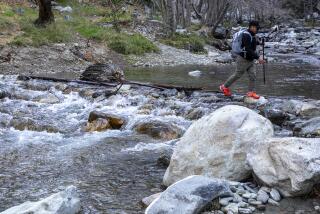Appalachian Trail, World’s Longest Path, Fulfills Hiker Dreams
- Share via
WOODY GAP, Ga. — The icy wind whipped a chill across the hazy mountains of north Georgia and left the weary hikers on the Appalachian Trail shivering in their well-traveled boots.
Mere cold, however, could not intimidate these modern pioneers. Loaded with ample backpacks and hefty dreams, they trudged through the wilderness pursuing their ambition one step at a time.
As thick clouds shrouded nearby peaks, Gerald and Alison Dickinson, former auto workers from New York who plan to spend the summer walking the trail from Georgia to Maine, paused briefly at a rest station to take a breather.
Counting the Miles
After only four days, they were tired and cold and counting the miles to their next cheeseburger, which they figured was at least two states away. But they were walking the Appalachian Trail, and their mood was sheer jubilation.
“I’ve stood in the middle of carburetors and wondered, ‘Why am I doing this and not out walking in the woods?’ ” Alison Dickinson said. “Now I’m finally hiking the trail. This is a lifelong dream.”
Each year, millions of people wander the twisting Appalachian Trail, the longest continuous footpath in the world. Most spend a day or two hiking it for exercise and peace of mind. Other intrepid travelers try to walk the entire length, 2,100 miles of mountainous terrain from Mt. Katahdin, Me., to Springer Mountain, Ga. Few actually finish. Over the years, only about 1,500 people--”thru-hikers,” as they are known on the trail--have covered the entire distance in one 12-month period.
Although the woods and mountains--and some of the paths--have always been there, the Appalachian Trail has not. This Friday r marks the 50th anniversary of the completion of the trail.
An American Heirloom
Those who spend time on the trail consider it an American heirloom, even at such a youthful age.
“It’s a national treasure,” said Daniel (Wingfoot) Bruce, a long-distance hiker from Conyers, Ga., who hiked the entire Appalachian Trail in 1985 and is walking it again this year with an Ohio man in a “Golden Anniversary Expedition” to commemorate the trail’s birthday. As authors use pen names, hikers use trail names. Wingfoot is Bruce’s trail name.
“The trail has served as the centerpiece of a greenbelt that in years to come will be even more valuable because it will be one of the last remaining wild areas in the eastern United States,” he said.
The Appalachian Trail was conceived in 1921 by Benton MacKaye, a forester and philosopher who proposed a lengthy interstate footpath connecting a series of recreation camps where city dwellers could enjoy nature.
Local groups got busy clearing paths in their own backyards and the Appalachian Trail Conference, the umbrella organization that still maintains the trail, was formed in 1925. Largely through the efforts of the conference, these local paths were connected, and, in 1937, the final stretch of trail was blazed and the Appalachian Trail was completed. However, the camps never materialized.
The AT, as it is fondly known to hikers, was a hit from the start with outdoors enthusiasts, but it did not grab the attention of the general public until the 1960s, when the nation was gripped by a back-to-nature epidemic. Now about 3 million to 4 million people annually set foot on the trail, which is within a day’s drive of half of the nation’s population and passes within a few miles of every major city on the East Coast. From one vantage point on the trail near the Hudson River, the lights of Manhattan are visible at night.
‘A Back-Country Resource’
“When you think about it, it’s really remarkable,” said Ted Unkles, a development specialist with the trail conference. “It’s a back-country resource that’s more accessible than any other back-country resource in North America.”
The trail winds through 14 states, eight national forests and six national parks, and each section has its own personality.
From northern Maine, the trail follows the rugged White Mountains of New Hampshire and the serene pockets of pines and waterfalls of New York, New Jersey and Connecticut. In Pennsylvania, the footing is so rocky that hiking boots wind up tattered. The longest stretch comes in Virginia, where the trail cuts through thick forests along the Blue Ridge. Hikers roam through the clouds in the Great Smoky Mountains along the Tennessee-North Carolina border.
Although Springer Mountain is generally considered the “terminus” of the trail, it more often than not is the starting point for thru-hikers, who usually set off on their journeys in early spring when the weather is still too harsh in New England.
Five Months: A Long Time
Each year, several hundred hearty souls start the trail with the best of intentions to finish it. But then come the blisters, cold rain and homesickness. Five months is a long time in the woods following the seemingly endless white blazes painted on trees and rocks, and 5 million steps--the estimated number it takes from end to end--can be excruciating.
Some drop out at the midway point, others last only a week. A few struggle up the 9-mile approach trail from Amicalola Falls to Springer Mountain, decide it is mistake, turn around and go home.
Only a few dozen manage to cover the distance each year. For those who do, the reward is a self-fulfilling accomplishment like no other.
Some celebrate by kissing the top of Mt. Katahdin, others don tuxedos to turn the finish into a formal affair. A few hikers, strangers at the beginning, develop a trail courtship and marry at the end.
Hikers Holler Pleasantries
There are no strangers on the trail and the camaraderie is contagious. The silence of the woods is constantly broken as hikers holler pleasantries to others passing by; if there’s time, a story or two will be shared. Many of the travelers stay together in small half-enclosed shelters and hostels that dot the trail about a day’s hike apart.
Although most hikers walk alone or in small groups along the narrow paths, there have been few accidents and crimes since the trail was opened. Hikers look out for one another.
“There are some wonderful stories,” said Jean Cashin, an information officer at conference headquarters in Harpers Ferry, W.Va., who welcomes hikers passing through like long-lost relatives. “There’s an attachment each hiker feels toward the other hikers. It’s a feeling of family. The trail is a meeting of the minds and the bodies.”
“One thing about the trail that a lot of people misunderstand is they think it’s a very lonely experience,” Wingfoot said. “But it’s actually quite a social experience. When I hiked it, of the 158 days on the trail, I was alone only 10 days.”
Like Mountain Climbing
Hiking the AT is very much like climbing a mountain; query those who tackle it and the reason is usually: “Because it’s there.”
John Meddaugh gently taped moleskin to blisters on his feet as he sat in the general store at Walasi-Yi, a supply depot for hikers downhill from Blood Mountain, Georgia’s highest peak.
“Whoever designed this part of the trail had a cruel sense of humor,” said Meddaugh, a resident of Austin, Tex., on a weeklong hike. “It’s up and down all the way.”
In the next room, Jim Corwin, a red-headed hiker from Ohio, and his buddy, Jon Morrow, were munching hot dogs and slugging back Cokes--their first sit-down meal since starting the trail three days earlier. Both are aiming for Maine, and both quit their jobs to get there. Asked to explain this crusade, Corwin, 25, who has hiked part of the trail before, laughed and said: “Complete foolishness.”
Not For Everyone
To outsiders, perhaps that best explains this endeavor. Lugging 45 pounds of gear on your back up and down hills for 15 miles a day, sleeping in the rain and existing on seeds, nuts and squeeze Parkay certainly does not sound like much fun.
The attraction is a communion with nature, an opportunity to live a simple life of self-reliance and a personal test of endurance.
“Every minute and every turn is different,” said Wingfoot, 39, a structural engineer. “For six months, I will not sleep in the same place, eat the same meals or see the same sites. I find that exhilarating.”
The Appalachian Trail is an odd entity. It is part private, part public. It is no longer operated by the federal government, which in an unprecedented move in 1984 turned over management of the trail to the Appalachian Trail Conference, a private group.
All trail maintenance is performed by a loosely allied network of local clubs, who keep paths in their areas cleared of tree limbs and other debris. Funds for any major work comes from the coffers of the conference, which has a rather measly 1987 budget of $1.2 million.
Revenue From Membership
Almost two-thirds of the money comes from membership dues--$25 per year for an estimated 20,000 conference members--and a service contract with the National Park Service. The rest stems from foundation grants, donations, and sales of maps, books and T-shirts.
Cashin characterized fund-raising as “a struggle.”
The trail itself has been altered over the years because of land development and safety.
In the past, a good portion of the trail ran alongside highways, but an intense effort to move the trail back into the woods has left only a small percentage of the walkway in direct competition with motor traffic.
Most Land Publicly Owned
In that vein, the federal government and the conference over the years have acquired a substantial amount of land in little chunks along the trail. Most of the trail land now is publicly owned, but in numerous spots the trail runs through the land of private owners who have an agreement with trail officials.
“If we had a pipe dream, we’d imagine a sort of Appalachian greenway . . . where the land could remain in private hands, but there would be some conservation control,” said Unkles, the conference’s development specialist. “This land would spread out for miles on either side of the trail. That’s not likely to ever come to fruition, but we’re going to work toward that condition.”
More to Read
Sign up for The Wild
We’ll help you find the best places to hike, bike and run, as well as the perfect silent spots for meditation and yoga.
You may occasionally receive promotional content from the Los Angeles Times.






